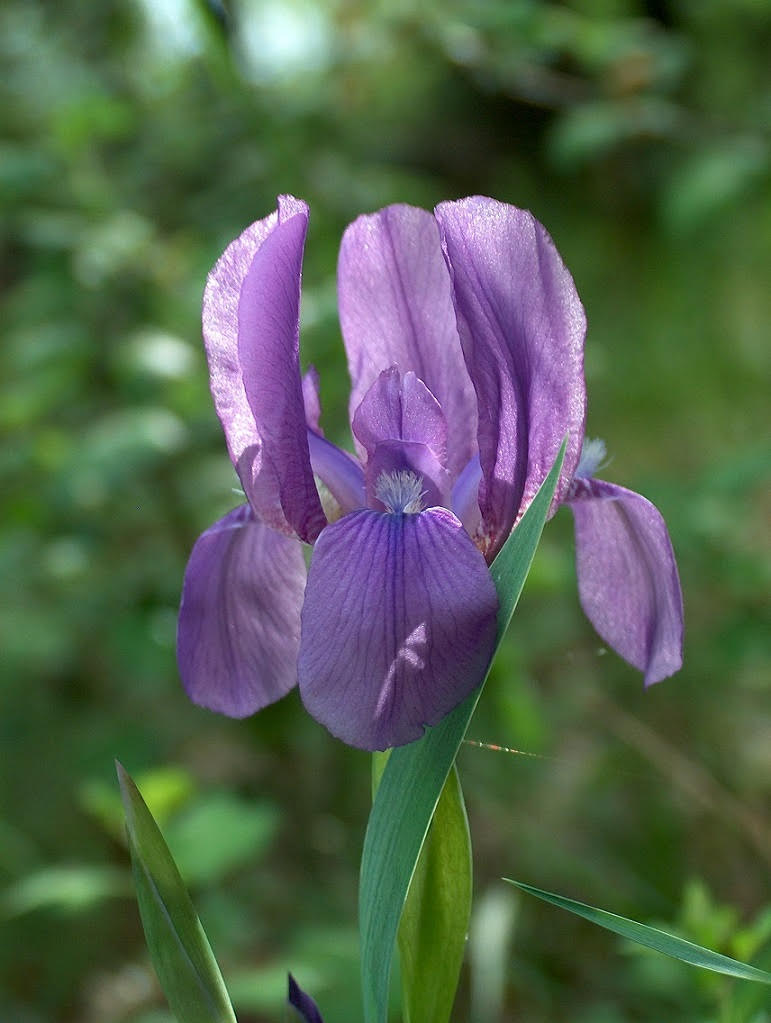Magyar nőszirom

Iris aphylla subsp. hungarica
Highly protected, community importance
The Hungarian leafless iris is a medium-sized, perennial, herbaceous plant growing to a height of 10-30 cm.
It has an upward-pointing, cylindrical, smooth, non-branching stem, although it might appear so due to its footstalk.
Its membranous, edged leaves have a sword-like shape. The leaves are approximately the same size as the stem and splay outwards.
Its six-partite flowers have a violet-purple red tone. It has 3 smaller tepals and 3 large sepals. The outer tepals have bearded pinnae, while the spathes are green with membranous edges. A single steam features 2-4 buds, with only one blooming at a time. The flower blooms in late April-May with capsule bearings containing six-partite ovoid seeds.
The poisonous, perennial plant’s thick rhizome forms extensive polycormones.
The Hungarian leafless iris is also featured on the twenty forint coin.
Spread:
The Iris aphylla is native to Central Europe, Asia Minor and Russia with the Hungarian leafless iris (Iris aphylla subsp. hungarica) as one of its subspecies. The “Hungarian” name is due to the fact that the entire world-stock of the plant is limited to the Carpathian Basin. It is a true cross-Pannonian, endemic forest steppe species.
Its domestic stock is known to be found in the North Hungarian Mountains, the Zemplén Mountains, the Cserehát Hills, the Putnok Hills, the Great Hungarian Plain and the Nyírség.
It grows in adobe soils of dry oak groves, on loose acidic sands, rocky meadows and the shallow skeletal soils of rocky and grassy slopes. It takes poorly to full shade and thus its stock found in wooded areas usually grows on the edges of clearings richer in sunlight.
Conservation status:
The Hungarian leafless iris is an endangered species exposed to numerous negative effects. In many cases, forestry poses a threat to our stock as forest restoration works carried out with comprehensive soil preparation and the forced logging of forest sections with clearings can result in the entire disappearance of various species.
In the case of multiple stocks, the spread of shrub species or the invasion of alien species poses a serious problem as heavily enclosed habitats result in weak growth and a regular lack of flowering. The declining groundwater levels also have an unfavourable effect on populations living in the loess areas of the Nyírség.
Similarly, the proximity to settlements or agricultural areas can also pose a problem as in the case of such areas, they fall victim to development or tilling.
As the iris is an imposing flower, those who collect such flowers can also cause significant damage. Multiple sites where the flower was known to grow have been decimated as the plants were entirely uprooted and planted in gardens.
Genetic contamination also poses a major threat. Hybrid plants can impede the genes of the entire stock.
Protection:
Pursuant to Council Directive 92/43/EEC of 1992 on the Conservation of natural habitats, the plant is a protected species of community importance under the title of NATURA 2000.
Not featured on the IUCN Red List.
Seven of the eight iris species found in Hungary – including the Hungarian leafless iris – are protected plants. The Hungarian leafless iris is a highly endangered species in the process of disappearing. In Hungary, the plant is highly protected with a conservation value of HUF 100,000.
